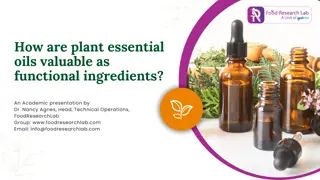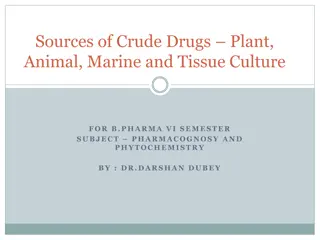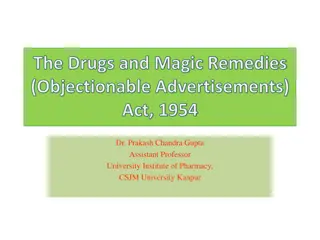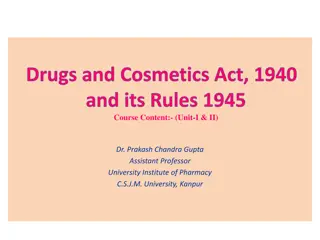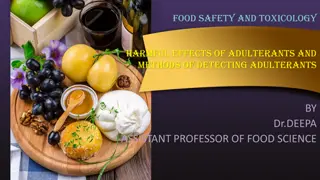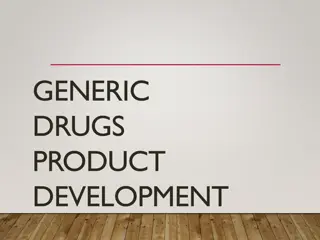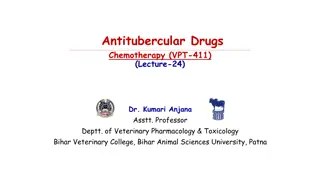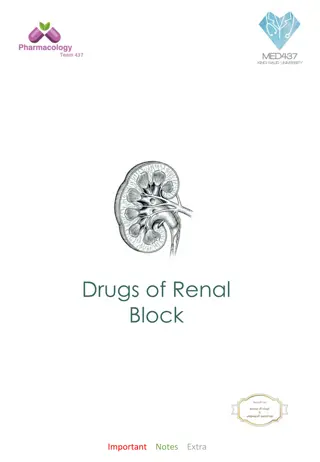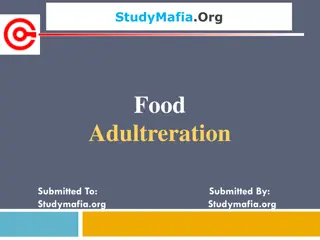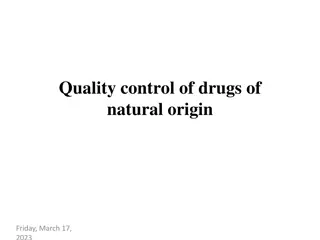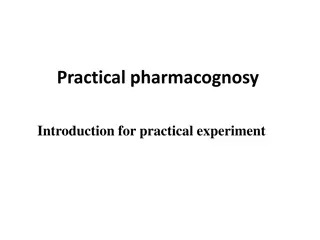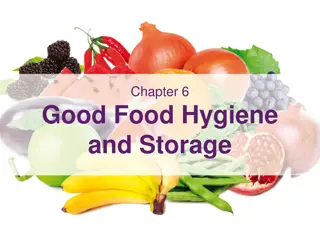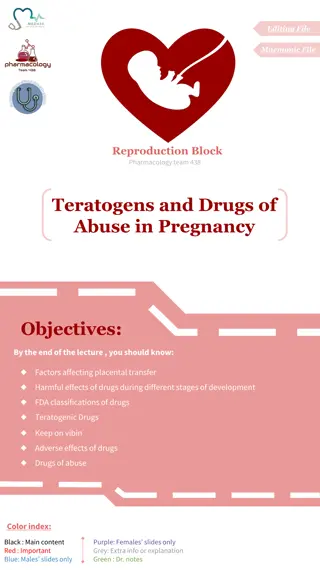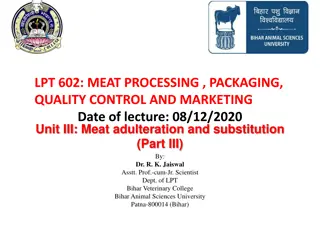Adulteration in Drugs and Food Industry
Adulteration is the deceptive practice of substituting original substances with inferior or harmful ones. Deliberate and accidental adulteration can lead to health risks and financial gains. Different types of adulterants, reasons for adulteration, and ways to prevent it are discussed in this informative content.
Download Presentation

Please find below an Image/Link to download the presentation.
The content on the website is provided AS IS for your information and personal use only. It may not be sold, licensed, or shared on other websites without obtaining consent from the author.If you encounter any issues during the download, it is possible that the publisher has removed the file from their server.
You are allowed to download the files provided on this website for personal or commercial use, subject to the condition that they are used lawfully. All files are the property of their respective owners.
The content on the website is provided AS IS for your information and personal use only. It may not be sold, licensed, or shared on other websites without obtaining consent from the author.
E N D
Presentation Transcript
LADI ALIK KUMAR ASST PROFESSOR, SOP, CUTM, RAYAGADA
Adulteration is a practice of substituting original crude drug partially or whole with other similar looking substances but the latter is either free from or inferior in chemical and therapeutic properties. OR
Adulteration in s imple words is the debasement of an article. OR Adulteration is broadly defined as admixture or substitution of original or genuine article/ drug with inferior, defective or otherwise useless or harmfulsubstances.
ADULTRANT: The adulterant must be some material which in both cheap and available in fairly large amounts.
1. Deliberate ( Intentional ) adulteration 2. Accidental ( In-deliberate) adulteration Deliberate adulteration Are normally commercial mainly with the intention of enhancement of profits
1. Scarcity of the drug 2. The high price of the drug in the market, eg: Clove, Cinnamon, Cardamom 3. It is very common with the contraband drugs e.g. Opium
The term 'adulteration' or debasement of an article covers a number of conditions, which may be deliberate or accidental.
Inferiority is a natural substandard condition (e.g. where a crop is taken whose natural constituent is below the minimum standard for that particular drug) which can be avoided by more careful selection of the plant material.
Spoilage is a s ubs tandard condition produced by microbial or other pes t infestation, which makes a product unfit for consumption, which can be avoided by careful attention to the drying, and storage conditions.
Deterioration is an impairment of the quality or value of an article due to destruction or abstraction of valuable constituents by bad treatment or aging or to the deliberate extraction of the constituents and the sale of the residueasthe originaldrugs.
Admixture another is the addition of one article to through accident, ignorance or carelessness e.g. inclus ion of s oil on an underground organ or the co-collection of two similarspecies.
Sophistication is the deliberate addition of spurious or inferior material with intent to defraud; such materials produced and may appear at first sight to be genuine e.g. powder ginger may be diluted with starch with addition of little coloring material to give the correct shade of yellow colour. are carefully
Substitution is the addition of an entirely different article in place of that which is required e.g. supply of cheap cottonseed oil in place of olive oil.
Different methods used for adulteration may be grouped asfollows: 1. Substitution with Varieties Due to morphological resemblance authentic drugs, different inferior commercial varieties are used asadulterant which may or may not have any chemical or therapeutic potential asthat original naturaldrug Inferior Commercial to the
E.g. Arabian Senna (Cassia angustifolia ) and dog Senna (Cassia obovata ) have been used to adulterate Senna(Cassiasenna) E.g. Japanese ginger ( Zingiber mioga ) to (Zingiber adulterate medicinal ginger officinale).
Adulteration Substitutes To provide the general form and appearance of by Artificially Manufactured 2. variousdrugs, somematerials are artificially manufactured and are used as substitute of the original one. E.g. artificial invert sugar for honey; paraffin wax after yellow coloration substituted for beeswax.
3.Substitution by ExhaustedDrugs Here the same plant material ismixed which is having no active medicinal components as they have already beenextracted out. This practice is most common in case of volatile oil containing materials like clove,fennel etc.,
where the dried exhausted material resembles the s ame like original drug (s imilarly with drugs like Cascara sagrada and ginger). Sometimes when coloring matters have been extracted or removed during exhaustion, the residue is re-colored with artificial dyes as is donewith saffronand red rosepetals.
4. Substitution by Superficially Similar but CheaperNatural Substances Usually here the adulterated product has no relation with the genuine article, may or may not have any therapeutic or chemical component desired,
Ailanthus e.g. leaves of species - are substituted for belladonna, senna, mint etc.; Leaves of Phytolacca and S copolia for belladona; Xanthium Leaves of for s tramonium and dandelion for henbane; Indian dill with European dill or carawayetc.
5. Adulteration by Addition of Worthless Heavy Materials A large mass of stone mixed with Liquorice root, pieces of limestone are found in as afoetida and lead s hot has occurred in pieces of opium etc.
6. Addition of SyntheticPrinciples Sometimes to fortify inferior natural products, synthetic principles are added e.g. adding citral to oil of lemon; benzyl benzoate to balsam of Peruetc.
7. Usage of Vegetative Matter from the Same Plant This isdone by mixing adventitious matters or naturally occurring with the drug in excessive amount or parts of plant other than that whichconstitutesthe drugs.
For growing in bark portion are mixed with example liver warts and epiphytes Cas cara or Cinchona; stems of buchu are sometimes cut into short lengths and added to thedrug.
Evaluation of Drugs: A natural substance is considered as food if it fills stomach in every day life without any harmful effect. A substance become drug if it change a pathological or disease state of human/animal to normal physiological condition having no undesirable effect in specific dose. A long-term studies (chemical, biological and physical etc) are required to establish whether a substance will be considered as drug or food or eliminate for consumption. Those studies are referred as evaluation. Evaluation of drug means Identification Determination of quality Determination of purity
Identification The identification can be established by careful observational study of the collected drug, and then compared with authentic specimen by the collector. Therefore, for proper identification of a drug from plant or animal sources, a collector must be educated about plant taxonomy and very much experienced with his/her job. Therefore, drugs from plants/animals are identified by A qualified, specialized & experienced personnel o Comparison with the authentic sample specimen. o In every country, there is a national herbarium where most of plants specimen are preserved. A number of specialists are working on plant identification there.
Quality The word quality refers to the intrinsic value of the drug, i.e., the amount of medicinal principles or active constituents present. These principles are classified as carbohydrate, alkaloid, glycoside, volatile oil, lipid, antibiotics and steroids etc. A high grade of quality in a drug is of primary importance. An effort should be made to obtain and maintain high quality. To maintain high quality products one should do the following: Select proper source (wild or cultivated) Appropriate time of collection Collection of required parts of plants (bark, leaf, stem, rhizome, root) Preparation of the collected drug by proper cleaning, drying. 1. 2. 3. 4. 5. Proper preservation to avoid contamination by microorganisms and moisture, heat, air and light.
Purity The purity of drug can be achieved by 1. Proper identification 2. Quality assurance.
Evaluation Method The of methods, which may be classified as follows: evaluation of a drug involves a number 1. Organoleptic 2. Microscopic 3. Biological 4. Chemical 5. Physical
1. Organoleptic evaluation of drug Organoleptic evaluation means the study of a drug with the help of organs of sense. It includes any drug s macroscopic or external appearance, color, odor, taste & sounds of its fracture etc. The macroscopic or external characteristic of a drug may be divided into 7 headings - 1. 2. 3. 4. 5. 6. Shape Size Color Fracture & internal color Odor Taste
2. Microscopic evaluation of drug Microscopic evaluation of drug can be done in the laboratory by the use of microscopes and utilizes various microscopic characters of the drugs, such as types and arrangement of various cells and tissues.
3. Chemical evaluation of drug Chemical evaluation of drugs involves both qualitative and quantitative determination of their active principles. In this method characteristic qualitative chemical tests are employed to identify crude drugs and their constituents.
4. Biological evaluation of drug The biological evaluation of crude drugs is very useful in determining the pharmacological activity of the drug. Since living organism or their isolated living tissues are used, this method is also called the biological method or bioassay. Many drugs, particularly the antibiotics, toxins and toxoids and also vitamines are assayed by this method.
5. Physical evaluation of drug The physical evaluation of crude drugs is accomplished by the determination of various physical characteristics using various physico-chemical techniques, for example, specific gravity (of fats and volatile oils), melting points (of alkaloids), optical rotation (of alkaloid and volatile oils), etc.



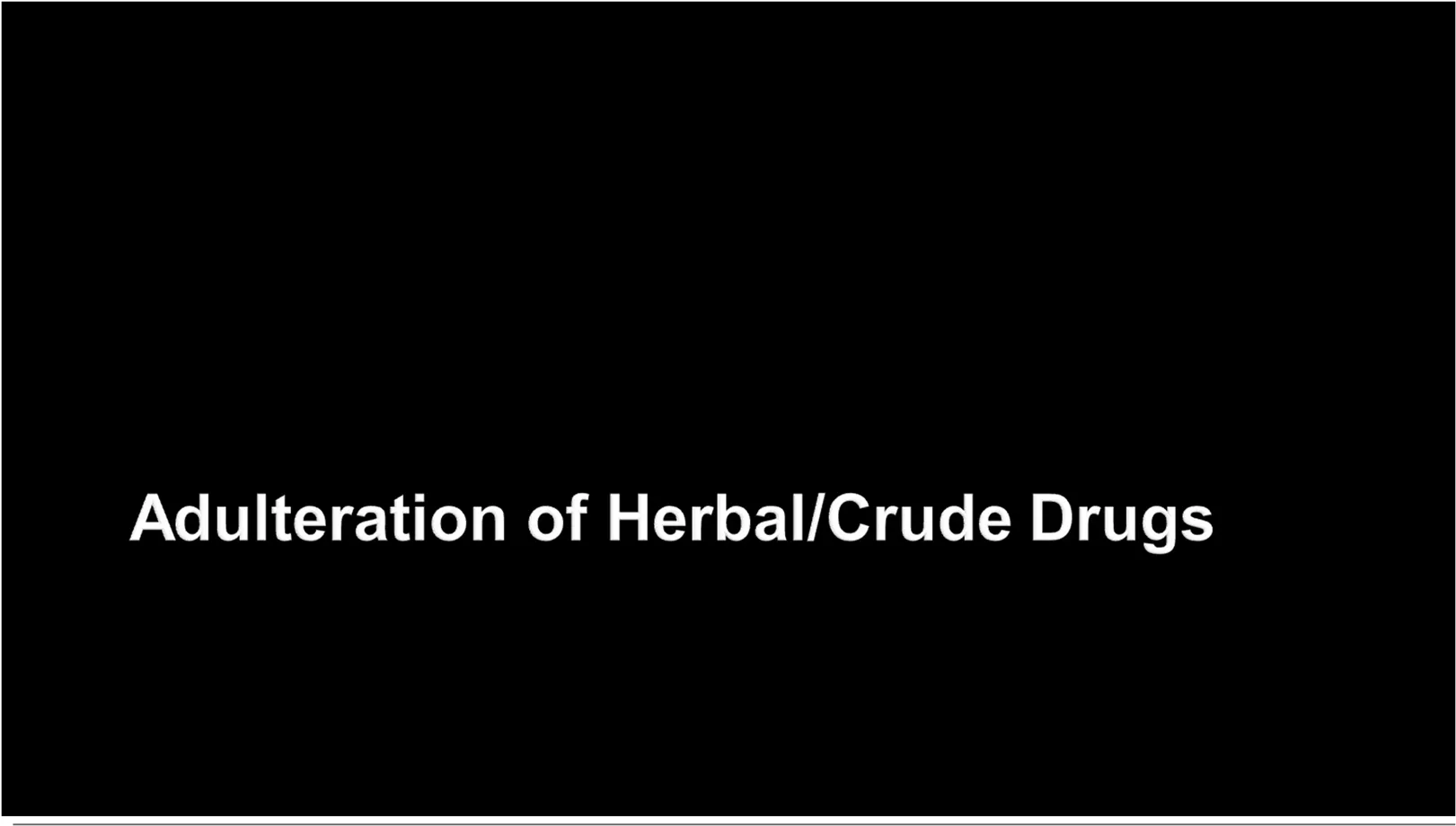
 undefined
undefined





